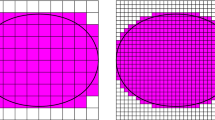Abstract
We convert constructive solid geometry input to explicit representations of polygons, polyhedra, or more generallyd-dimensional polyhedra, in time and space 0(nd), improving a previous0(nd logn) time bound. We then show that any Boolean formula can be preprocessed in time0(n log n/log logn) and linear space so that the value of the formula can be maintained, as variables are changed one by one, in time O(log n/log logn) per change; this speeds up certain output-sensitive algorithms for constructive solid geometry.
Similar content being viewed by others
References
B. Chazelle. An optimal algorithm for intersecting three-dimensional convex polyhedra.Proceedings of the 30th IEEE Symposium on Foundations of Computer Science, 1989, pp. 38–48.
B. Chazelle and H. Edelsbrunner. An optimal algorithm for intersecting line segments in the plane.J. Assoc. Comput. Mech.,39 (1992), 1–54.
R. F. Cohen and R. Tamassia. Dynamic expression trees and their applications.Proceedings of the 2nd ACM/SIAM Symposium on Discrete Algorithms, 1991, pp. 52–61.
D. Dobkin, L. Guibas, J. Hershberger, and J. Snoeyink. An efficient algorithm for finding the CSG representation of a simple polygon.Comput. Graphics,22 (1988), 31–40.
D. P. Dobkin and D. G. Kirkpatrick. Fast detection of polyhedral intersection.Proceedings of the 9th International Colloquium on Automata, Languages, and Programming, 1982, pp. 154–165. LNCS, Vol. 140. Springer-Verlag, Berlin.
H. Edelsbrunner,Algorithms in Combinatorial Geometry. EATCS Monographs on Theoretical Science. Springer-Verlag, Berlin, 1987.
H. Edelsbrunner and L. J. Guibas. Topologically sweeping an arrangement.J. Comput. System Sci.,38 (1989), 165–194.
G. N. Frederickson. Ambivalent data structures for dynamic 2-edge-connectivity andk smallest spanning trees.Proceedings of the 32nd IEEE Symposium on Foundations of Computer Science, 1991, pp. 632–641.
M. T. Goodrich. Applying parallel processing techniques to classification problems in constrictive solid geometry.Proceedings of the 1st ACM/SIAM Symposium on Discrete Algorithms, 1990, pp. 118–128.
M. S. Paterson and F. F. Yao. Binary partitions with applications to hidden-surface removal and solid modelling.Proceedings of the 5th ACM Symposium on Computational Geometry, 1989, pp. 23–32.
R. B. Tilove. Set membership classification: a unified approach to geometric intersection problems.IEEE Trans. Comput.,29 (1980), 874–883.
R. B. Tilove. A null-object detection algorithm for constructive solid geometry.Comm. ACM,27 (1984), 684–694.
Author information
Authors and Affiliations
Additional information
Communicated by Chee-Keng Yap.
Rights and permissions
About this article
Cite this article
Eppstein, D. Asymptotic speed-ups in constructive solid geometry. Algorithmica 13, 462–471 (1995). https://doi.org/10.1007/BF01190849
Received:
Revised:
Issue Date:
DOI: https://doi.org/10.1007/BF01190849




